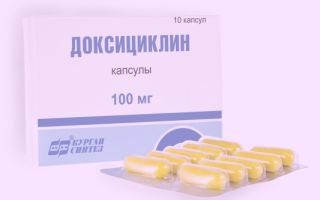Release form
Capsules 50 and 100 mg.
Mechanism, spectrum of action
Semi-synthetic antibiotic of the tetracycline group with a broad spectrum of action. It has a bacteriostatic effect by suppressing the protein synthesis of pathogens.
After oral administration, it is quickly and almost completely absorbed from the gastrointestinal tract. Food intake has little effect on the absorption of doxycycline. Widely distributed in tissues and body fluids.
Effective against malaria Pl. falciparum with drug resistance (in addition to quinine) and for toxoplasmosis .
Contraindicated during pregnancy and children under 8 years of age.
Application diagram
Toxoplasmosis, malaria: orally for adults and children over 12 years of age weighing more than 45 kg - 0.2 g on the first day, 0.1 g on the following days (in severe cases - 0.2 g) in 1-2 doses ; the maximum dose is 0.3 g per day.
Children 8-12 years old with body weight up to 45 kg on the first day - 4-5 mg/kg body weight per day, in subsequent days - 2-2.2 mg/kg body weight per day (for severe cases - 4 mg/kg) in 1-2 doses.
Course – 10 days.
Prevention of resistant malaria: adults and children over 8 years of age - 100 mg daily 2 days before departure to the zone, during stay (within 4 months) and 4 weeks after return.
The scientific information provided is general and cannot be used to make a decision about the possibility of using a particular drug.
There are contraindications, consult your doctor.







